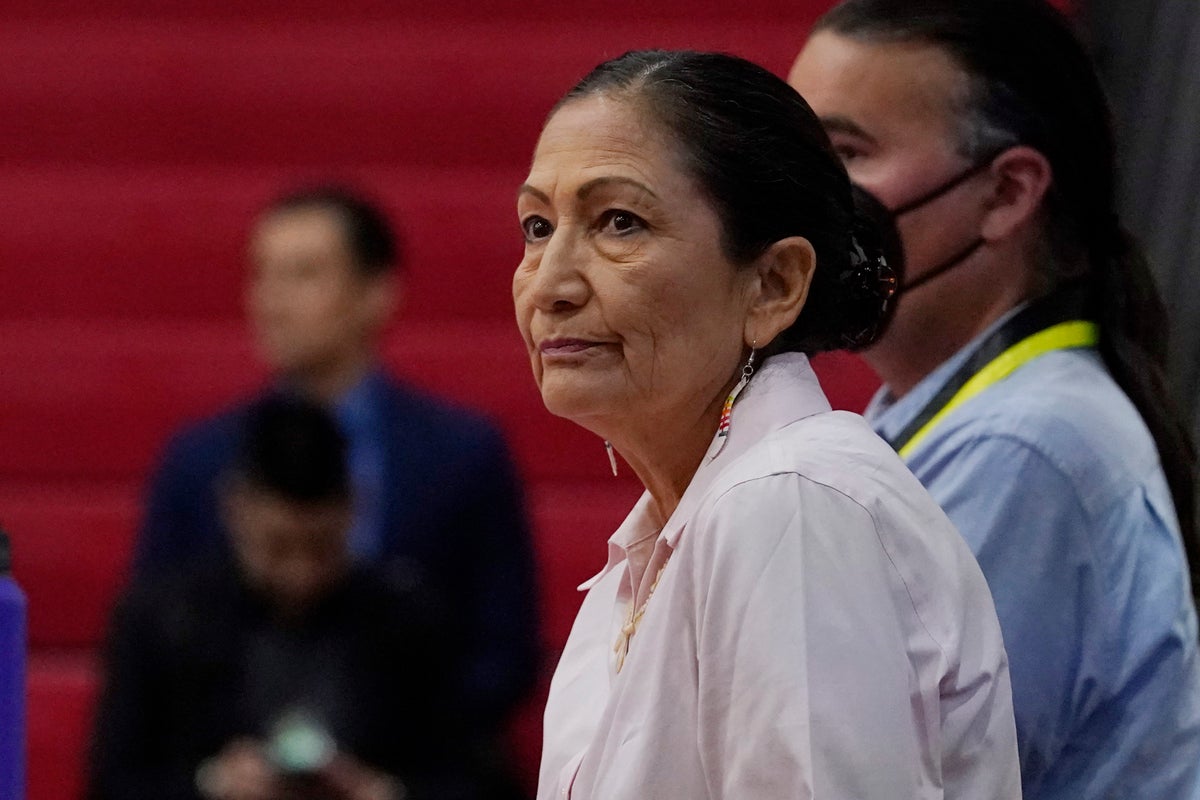
EDITORS/NEWS DIRECTORS:
A solemn weekend gathering in Oklahoma marked the start of Interior Secretary Deb Haaland’s yearlong nationwide tour to hear about the painful experiences of Native Americans who were sent to government-backed boarding schools.
The “Road to Healing” tour is aimed at giving Native American, Alaska Native and Native Hawaiian survivors of the federal boarding school system an opportunity to connect with support and share their stories for an oral history collection.
It's part of a broader initiative Haaland launched last year to investigate the troubled legacy of Indigenous boarding schools, which the government established and supported for decades to strip Native Americans of their identities.
The network of schools was vast, sprawling across the country and causing ripples in tribal communities all around the U.S. Oklahoma had the most, with 76 schools, while Arizona and New Mexico each had more than 40.
“Federal Indian boarding school policies have touched every Indigenous person I know,” Haaland said at the start of Saturday's event, which attracted Native Americans from throughout the region. “Some are survivors. Some are descendants. But we all carry the trauma in our hearts."
Haaland's tour will continue this year with stops in Arizona, Hawaii, Michigan and South Dakota, though specific dates have not been set. More states will be announced for 2023.
Here are some tips for localizing the story:
REPORTING RESOURCES
— The first volume of an investigative report released by the Interior Department in May identified more than 400 schools that the federal government supported, starting in the late 19th century and continuing through the late 1960s. It also found at least 500 children died at some of the schools, though that number is expected to increase dramatically as research continues.
Read the report here: https://www.bia.gov/sites/default/files/dup/inline-files/bsi_investigative_report_may_2022_508.pdf
— Find a state-by-state list of schools here: https://www.bia.gov/sites/default/files/dup/inline-files/appendix_a_b_school_listing_profiles_508.pdf
— Maps of federal boarding schools: https://www.bia.gov/sites/default/files/dup/inline-files/appendix_c_school_maps_508.pdf
— Additional information:
National Native American Boarding School Healing Coalition, https://boardingschoolhealing.org/
Native American Rights Fund, https://www.narf.org/cases/boarding-school-healing/
National Museum of the American Indian, https://americanindian.si.edu/nk360/code-talkers/boarding-schools/
QUESTIONS TO ASK
— Locate any schools that operated in your area. Which children were sent to those schools? The Interior report found some students intentionally were sent to boarding schools far from home to disrupt families and Indigenous communities.
— Are any survivors from these schools speaking out about their experiences? Are local tribal leaders taking any action?
— Are any tribes in your area working to bring home children who died and were buried at boarding schools? If you have burial sites in your area, what has been done to protect and memorialize them?
— The Interior report cited studies that found boarding school policies impacted several generations of Indigenous families. What does healing look like for Native American tribes, Alaska Native villages or Native Hawaiian communities near you?
— Are the schools in your area still open? What function do they serve now? How has the mission of the schools changed?
— What do public and private schools in your area teach about the boarding school era and the federal government’s role in establishing and supporting them?
— Are there local museums with exhibits on the boarding school era? How do visitors who are unfamiliar with the schools engage with and react to what they see?
PUBLISHABLE CONTEXT
Starting with the Indian Civilization Act of 1819, the U.S. enacted laws and policies to establish and support Native American boarding schools. The U.S. government often worked hand in hand with religious institutions to assimilate and convert Native Americans to Christianity.
Parents often were coerced into sending their children to boarding schools. Some survivors have reported their parents were threatened with imprisonment, told that welfare assistance would be withheld or their children would be taken away if they refused to send them to boarding school.
Children were subjected to manual labor as part of boarding school curricula. They were prohibited from speaking the only languages they knew, had their long hair — sacred in many Indigenous communities — cut, their names changed and were separated by gender.
Many children endured emotional, spiritual and physical abuse at the schools that included whipping, slapping and being handcuffed when they didn’t follow the rules, according to the Interior’s investigation. Others suffered sexual abuse.
Congress appropriated money to run the schools, but the federal government also used money held in trust for tribes as compensation for land that tribes ceded.
The federal government today oversees more than 180 schools in nearly two dozen states that serve Native Americans, but the schools’ missions are vastly different from the past. The U.S. Bureau of Indian Education directly operates some, including Haskell Indian Nations University in Kansas, where more than 100 students from its boarding school days are buried. Tribes or tribal organizations operate other schools under contract with the federal government.
The Interior Department identified more than 1,000 other federal and non-federal institutions outside the scope of its investigation that include day schools, sanitariums, asylums, orphanages and stand-alone dormitories that also could have educated Indigenous people.
Meanwhile, Congress is considering a bill to create a truth and healing commission, similar to one established in Canada in 2008. It would have a broader scope than the Interior Department’s investigation into federally run boarding schools and subpoena power, if passed.
STYLE TIP
Stories involving abuse and intergenerational trauma tied to Indigenous boarding schools can be triggering to some readers. Consider adding an editor’s note to your coverage flagging disturbing content and pointing readers to trauma resources, like this list compiled by the National Native American Boarding School Healing Coalition, or the National Sexual Assault Hotline: 1-800-656-4673.







